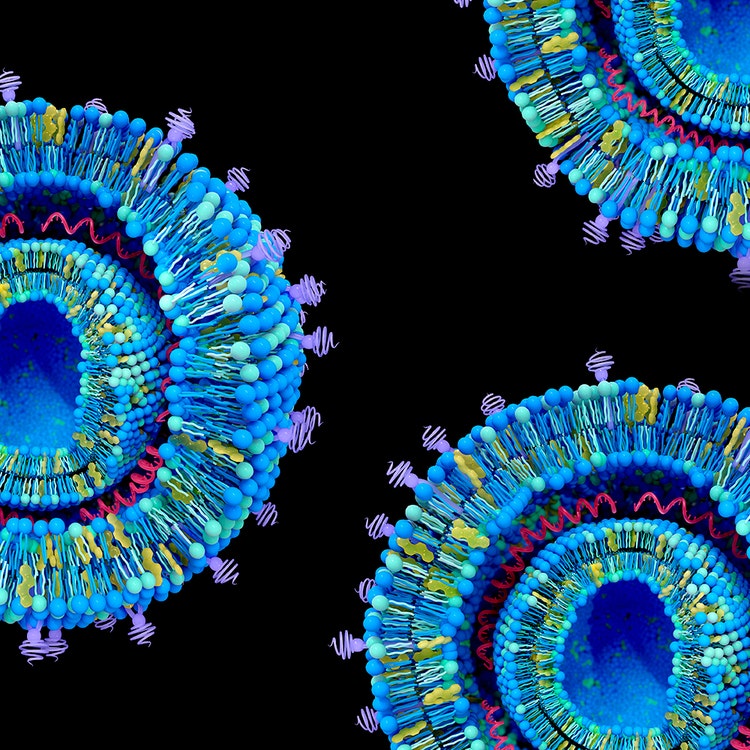Lipid Nanoparticles

Lipid Nanoparticles for mRNA Delivery
Why It Matters
Lipid Nanoparticles are Transforming mRNA Therapeutic Delivery
Lipid nanoparticles (LNPs) play a pivotal role in advancing mRNA therapeutic potential, serving as an innovative delivery system that enhances the efficacy and safety of these treatments. By encapsulating mRNA within LNPs, fragile genetic material is protected from degradation, ensuring it reaches target cells intact, where it is translated to produce the desired proteins. This innovative delivery approach improves cellular targeting and enables better control over the distribution of the mRNA, maximizing therapeutic impact. As the demand for personalized and targeted therapies grows, leveraging lipid nanoparticles in mRNA delivery allows for rapid scalability and adaptability in responding to emerging health challenges like the COVID-19 pandemic, making them essential for realizing the full potential of mRNA therapies in treating a diverse range of diseases. Embracing LNPs is not just about enhancing treatment efficacy; it’s about transforming patient care.
Select the Right Tools and Partner
Developing and manufacturing LNPs for mRNA therapeutics requires high consistency in process and quality. Selecting the right tools and partnering with scientific experts is essential to achieve this.
The Life Sciences companies of Danaher offer a wide range of solutions and technologies to support LNP development and manufacturing. We can elevate your program with innovative analytical solutions and enterprise-level data management tools. Our offerings are designed to empower you and help you reach your goals quickly and efficiently.
The Process
The LNP Workflow
One lab, three paths to faster cell line development outcomes
Resources
Resources for Lipid Nanoparticle
Method validation and references
SCIEX
mRNA-LNP nucleic acid assessment from distinct formulations by multi-capillary gel electrophoresis
Application Note
SCIEX
A new approach to determine encapsulation efficiency of mRNA-lipid nanoparticles (mRNA-LNP) by capillary gel electrophoresis with laser-induced fluorescence detection
Application Note
SCIEX
Automatic characterization of the lipid nanoparticle ionizable lipid MC3 and its impurities using Molecule Profiler software
Scientific and Technical Report
Molecular Devices
RiboPro use the SpectraMax iD3 to advance research into life-changing mRNA therapeutics
Application Note
Product Spotlight
FAQs
What is lipid nanoparticle delivery?
Lipid nanoparticle delivery is an advanced method for transporting mRNA therapeutics into cells using tiny lipid-based particles. By encapsulating mRNA within these lipid nanoparticles, the fragile genetic material is shielded from degradation, ensuring it remains intact as it travels to and enters target cells. Once inside, the mRNA is translated to produce the necessary proteins for therapeutic effects. This delivery system enhances both the effectiveness and safety of mRNA treatments by improving how well cells take up the mRNA and allowing precise control over its distribution within the body. Additionally, lipid nanoparticles are highly adaptable and scalable, making them ideal for creating personalized and targeted therapies and for quickly addressing emerging health challenges, such as pandemics. Overall, lipid nanoparticle delivery not only boosts the efficacy of mRNA-based therapies but also plays a crucial role in transforming patient care.
How are lipid nanoparticles formed?
Lipid nanoparticles are formed using various techniques that can be broadly classified into high-energy, low-energy, and organic solvent-based methods.
High-energy techniques, including high-pressure homogenization (HPH), supercritical fluid technology (SCF), ultrasonication, and flash nanocomplexation (FNC), leverage intense physical forces to create nanoparticles with precise size and uniformity. These methods, characterized by mechanisms such as shear stress, cavitation, and controlled solubility, are integral to scalable lipid nanoparticle production despite challenges like energy intensity and potential material degradation.
Low-energy methods, such as thin-film hydration, reverse phase evaporation, and microfluidic-assisted techniques, exploit thermodynamic and solubility properties of excipients to create lipid nanoparticles under mild conditions. These approaches minimize physical stress, offering precise particle control and enhanced stability, making them ideal for encapsulating sensitive drugs while preserving their integrity.
Organic solvent-based methods, such as solvent emulsification–evaporation, solvent emulsification–diffusion, and solvent injection, leverage lipid solubility in organic solvents to produce nanoparticles with precise size and encapsulation efficiency. Despite their effectiveness for diverse drugs, these techniques face challenges with solvent removal, toxicity, and potential degradation of sensitive compounds.
What are the components of lipid nanoparticles?
The composition of lipid nanoparticles consists of four key elements: ionizable cationic lipids, phospholipids, cholesterol, and PEG-anchored lipids. Each of these components plays a crucial role in ensuring the lipid nanoparticles remain stable, achieve high transfection efficiency, and maintain safety standards.
What are the advantages of nanoparticles in drug delivery?
As drug carriers, nanoparticles present several key technological advantages: they exhibit strong stability, possess a large capacity for drug loading, and can accommodate both hydrophilic and hydrophobic compounds. Moreover, they allow for diverse administration routes, including oral and inhalation methods. Nanoparticles can be tailored to enable controlled or sustained drug release from their matrix. These features contribute to increased drug bioavailability, reduced dosing frequency, and potentially improved patient adherence to prescribed therapies.
What is the process of developing lipid nanoparticles?
The formation of lipid nanoparticles involves several key steps to ensure their efficacy and stability. A lipid library is initially prepared by selecting lipid components capable of safely and effectively delivering the therapeutic cargo. The optimal composition and lipid ratios are determined to achieve the desired stability, cellular uptake, and therapeutic outcomes. The formulation undergoes rigorous optimization, scaling, and characterization using analytical methods to support GMP manufacturing. Lipids and therapeutic cargo, such as mRNA, are mixed to form nanoparticles, which are further prepared for analytical qualification and in vivo studies. The process is then transitioned to a Process Development laboratory for scaling and tech transfer, ensuring the final product meets quality and regulatory standards. This structured approach ensures robust nanoparticle production for clinical and commercial applications.